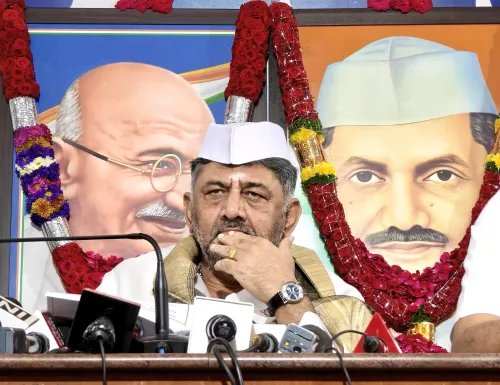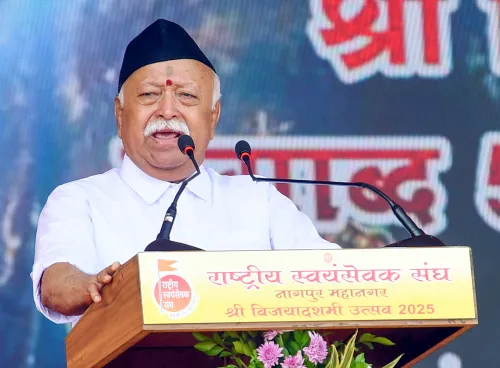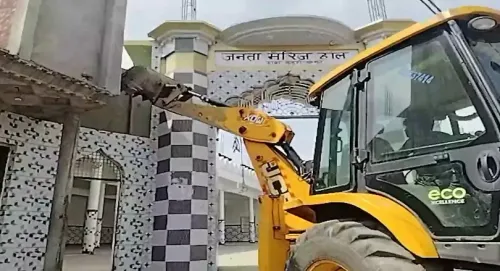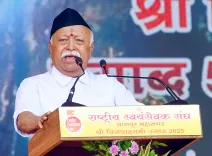How Do Women Celebrate ‘Sindoor Khela’ on Vijayadashami?
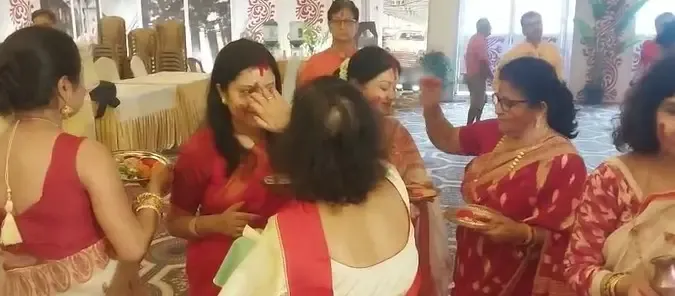
Synopsis
Key Takeaways
- ‘Sindoor Khela’ is a traditional ritual celebrated on Vijayadashami.
- It symbolizes prayers for marital happiness and the Goddess's return.
- Women participate in vibrant celebrations, often dressed in red and white saris.
- The ritual signifies the triumph of good over evil.
- The emotional farewell resonates with a spirit of hope and anticipation.
New Delhi, Oct 2 (NationPress) Women throughout India joyfully participated in the age-old tradition of ‘Sindoor Khela’ on Vijayadashami this Thursday, symbolizing the end of the nine-day Durga Puja festival.
Devotees expressed that as the Mother Goddess dwells with her followers for nine days before returning to her heavenly abode, this ritual is performed to invoke blessings for eternal marital happiness and to invite her back next year.
In Delhi, the farewell to Maa Durga Mataji unfolded at the Durga Puja pandal located in Mayur Vihar Phase 1, East Delhi. Prior to the ceremonial immersion, puja rituals were observed, after which women celebrated Sindoor Khela by adorning each other with vermilion. Participants emphasized that this tradition embodies their prayers for enduring marital joy and a hopeful reunion with the Goddess next year.
In Ranchi, women from the Bang community engaged in applying vermilion to each other at the Durga temple grounds in Durgabari on Vijayadashami. This ritual served as a prayer for everlasting marital bliss. The devotees noted that since Mother Durga triumphed over the demon Mahishasur, Sindoor Khela commemorates her victory—the triumph of good over evil. As dusk approached, devotees bid farewell to the Goddess amidst a vibrant display of vermilion.
Kolkata witnessed a simultaneous celebration of Devibaran and Sindoor Khela on the morning of Dashami at various pandals and residential complexes throughout the city. Festivities commenced early at major puja pandals, including locations like the Urbana Housing Complex.
The atmosphere was filled with the sounds of conch shells, Ululudhvani, and the rhythmic beating of drums, creating a deeply emotional ambiance among the devotees. Traditionally, women clad in red and white saris first honored Goddess Durga by applying sindoor to her forehead before engaging in Sindoor Khela, illuminating their faces, saris, and the entire environment with excitement.
At the Urbana Housing Complex in Kolkata, crowds of men and women gathered in the early hours. The farewell ceremony began with prayers and offerings to the Goddess, followed by women immersing themselves in Sindoor Khela, filling the area with joy as people embraced and exchanged warm wishes.
This heartfelt scene echoed throughout Kolkata, from South to North. Across grand pandals and small neighborhood puja committees, devotees were wrapped in emotion. The Goddess’s departure was met with hopeful anticipation, expressed in the popular refrain, “Aasche Bochhor Abar Hobe” (“It will happen again next year”).
Bengal’s renowned Durga Puja festival is celebrated widely for the joy it brings along with the blessings of Maa Durga. From the traditional Dhunochi Naach (incense dance) to the elegant white sari with red borders, this festival has gained remarkable popularity across India.

